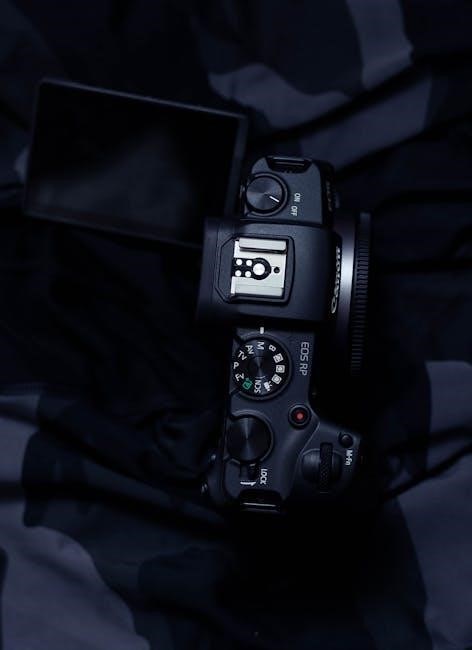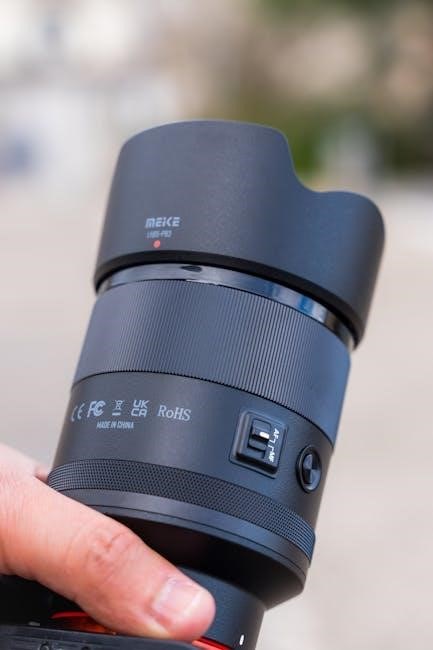
Overview of Square D Pressure Switches
Square D pressure switches‚ particularly the Pumptrol series‚ are trusted for residential‚ commercial‚ and industrial pumping applications․ These electromechanical switches activate water pumps within power circuits by sensing pressure changes․ They are known for reliability and durability‚ making them a preferred choice for various systems․
Square D‚ a brand by Schneider Electric‚ has established itself as a leader in pressure switches‚ particularly with its renowned Pumptrol series․ For over 65 years‚ Pumptrol pressure switches have been the go-to choice for monitoring and controlling electrically driven water pumps in residential‚ commercial‚ and industrial settings․ These switches are designed for direct control of motors in pump and compressor applications‚ ensuring reliable performance․
The Pumptrol series is known for its diaphragm-actuated operation and adjustable differential‚ allowing for precise control․ The brand’s reputation for quality and durability makes Square D a trusted name in pressure control․ The FSG series‚ in particular‚ stands out for its robustness and versatility in various pumping applications․
Common Applications of Square D Pressure Switches
Square D pressure switches are versatile components used across various applications due to their reliability and precise control․ A primary application is in water well pump systems‚ where they maintain water pressure by controlling the pump’s operation․ These switches are also commonly found in air compressors‚ ensuring consistent air pressure for pneumatic tools and machinery․
In industrial settings‚ Square D pressure switches are used for monitoring and controlling pressure in hydraulic systems‚ lubrication systems‚ and other fluid-based processes․ They are also utilized in HVAC systems to regulate pressure in refrigerant lines‚ ensuring efficient operation․ Additionally‚ these switches find applications in irrigation systems‚ fire suppression systems‚ and even specialized equipment requiring accurate pressure management․ Their robust design and adjustable settings make them suitable for a wide array of environments and applications․
Understanding the 9013 Series
The Square D 9013 series encompasses pressure switches designed for control of electrically driven water pumps․ These switches feature diaphragm actuation and adjustable differentials‚ catering to diverse pressure control needs in various applications․
Features of the 9013 Square D Pressure Switch
The Square D 9013 pressure switch is designed to control electrically driven water pumps‚ utilizing diaphragm actuation for pressure sensing․ Its differential increases with range‚ and contacts open on increased pressure․ Enclosed in a general-purpose NEMA Type 1 enclosure‚ it’s suitable for various environments․ These switches are individually boxed‚ with bulk packaging options available upon request․ Furthermore‚ the 9013 series is third-party certified to NSF/ANSI 372‚ ensuring compliance with safety and health standards․
The 9013 series is also highly tolerant of system surges․ For enhanced user control‚ some models feature a manual cut-off lever‚ allowing for temporary disconnection of the pump․
Manual Cut-Off Lever Functionality
The manual cut-off lever on certain Square D pressure switches‚ such as the 9013FSG2J24M4‚ provides a crucial function for system maintenance and safety․ This lever allows users to manually disconnect the pump‚ offering a temporary shut-off independent of pressure settings․
Specifically‚ the lever on models like the 9013FSG2J24M4 must be held upward until the line pressure exceeds approximately 20 psi during initial pump operation․ This feature is particularly useful for priming the pump or preventing it from running dry․ The manual cut-off lever offers a convenient way to override automatic operation for specific maintenance or troubleshooting tasks․

Technical Specifications and Wiring
Square D pressure switches have defined electrical ratings and wiring configurations․ Understanding these specifications ensures safe and effective installation․ Accurate wiring is critical for proper functioning․
Pressure Settings and Adjustment
Square D pressure switches‚ particularly in water well pump systems‚ utilize a double-spring mechanism for precise pressure control․ One spring governs the cut-in pressure‚ which initiates pump operation‚ while the other manages the cut-out pressure‚ stopping the pump․ A typical low-pressure setup involves a cut-in pressure of 20 PSI and a cut-out pressure of 40 PSI․
Adjustments to these settings are made using adjustment screws․ Adjust the larger screw to adjust the cut-out pressure and the smaller screw adjusts the differential pressure․ It’s important to monitor the pressure gauge during adjustments to ensure accurate settings․ Always check switch operation after adjustment to ensure proper functioning․ The range scale refers to the permissible setting for this equipment
Wiring Diagram and Electrical Ratings
Square D pressure switches are designed with specific electrical ratings to ensure compatibility and safe operation with various pump systems․ Typically‚ these switches are dual-pole and HP-rated‚ supporting 1-1/2 HP at 115V and 2 HP at 230V․ Accurate wiring is crucial‚ often involving four terminals for power and pump connections․
The two inside terminals should be wired to the pump/motor․ A standard wiring configuration involves connecting both black wires on one side and both red/white wires on the other․ Always consult the wiring diagram provided with the switch‚ noting that live electrical current is present․ Ensure proper grounding and adherence to electrical codes to prevent hazards and ensure reliable performance․

Troubleshooting and Maintenance
Maintaining Square D pressure switches involves preventive measures and addressing common issues․ Regular checks ensure optimal performance and longevity․ Troubleshooting steps often include verifying pressure settings and inspecting for wear or damage to maintain system reliability․
Preventive Maintenance Guidelines
To ensure the longevity and reliable operation of your Square D pressure switch‚ establishing a routine preventive maintenance schedule is crucial․ Regularly inspect the switch for any signs of physical damage‚ such as cracks or leaks‚ which could compromise its functionality․ Verify that the electrical connections are secure and free from corrosion‚ as loose or corroded connections can lead to erratic performance․
Periodically check the pressure settings to ensure they align with the system’s requirements․ Clean the diaphragm and internal components to prevent debris buildup‚ which can affect the switch’s accuracy․ Moreover‚ it is important to monitor the pressure gauge during operation to determine the switch’s on and off points‚ making adjustments as needed to maintain optimal system pressure․ By adhering to these guidelines‚ you can significantly extend the lifespan of your Square D pressure switch and minimize the risk of unexpected failures․
Troubleshooting Common Issues
When dealing with a malfunctioning Square D pressure switch‚ a systematic approach to troubleshooting can save time and effort․ Begin by verifying the power supply to the switch and confirming that the circuit breaker is not tripped․ Check the pressure gauge to ensure it is accurately reflecting the system pressure‚ as a faulty gauge can lead to misdiagnosis․ Inspect the switch for any signs of physical damage or leaks‚ and clean any debris that may be obstructing the diaphragm’s movement․
If the pump is not activating‚ examine the electrical connections for corrosion or looseness․ If the pump cycles too frequently‚ adjust the differential setting or check for leaks in the system․ Should the pressure switch fail to cut off the pump‚ inspect the contacts for wear or damage․ Always consult the Square D manual for specific troubleshooting steps and safety precautions before attempting any repairs․ Addressing these common issues promptly can help restore the pressure switch to proper working order․

Adjusting Pressure Settings
Modifying pressure settings on Square D switches involves understanding cut-in and cut-out pressures․ Adjustments are typically made using screws‚ following the manufacturer’s instructions․ Monitor a pressure gauge during the adjustment process for accurate calibration․
Step-by-Step Adjustment Guide
Step 1: Monitor the pressure gauge to determine the current cut-in and cut-out pressures․ Step 2: Identify the adjustment screws‚ usually located on top of the switch․ The larger screw typically adjusts the overall pressure range‚ while the smaller screw adjusts the differential․ Step 3: To increase the cut-out pressure‚ tighten the larger screw incrementally‚ and to decrease it‚ loosen the screw․ Step 4: Adjust the smaller screw to modify the pressure differential between the cut-in and cut-out points; Step 5: After each adjustment‚ operate the system to verify the new settings․ Repeat adjustments as needed until the desired pressure range is achieved‚ ensuring it aligns with system requirements․ Always consult the specific manual for the model for detailed instructions․
Understanding Cut-In and Cut-Out Pressures
Cut-in pressure refers to the pressure level at which the pressure switch activates the water pump‚ initiating the filling of the water tank․ Conversely‚ cut-out pressure is the level at which the switch deactivates the pump‚ stopping the filling process․ The difference between these two pressures is known as the differential․ For instance‚ a 40/60 switch activates the pump at 40 psi (cut-in) and stops it at 60 psi (cut-out)․ Understanding these settings is vital for maintaining optimal water pressure and preventing pump damage․ Adjusting these values correctly ensures consistent water supply and efficient pump operation․ Proper calibration‚ with a precise cut-in and cut-out pressure‚ is crucial for reliable water system performance․

Safety and Precautions
Safety is paramount when working with Square D pressure switches․ Always disconnect power before maintenance or adjustments․ Exceeding maximum pressure and temperature ratings can cause failure or injury․ Read all instructions thoroughly․
Warnings and Safety Instructions
Before installing‚ servicing‚ or adjusting a Square D pressure switch‚ always disconnect power to prevent electrical shock․ Thoroughly read and understand the operating instructions to avoid device failure‚ system damage‚ or personal injury․ Ensure the switch is correctly rated for the application’s voltage and horsepower to prevent overloading․ Never exceed the maximum allowable pressure specified for the switch model‚ as this can lead to rupture and potential harm․ Regularly inspect the switch for signs of wear or damage‚ and replace it if necessary․ When working with pressure systems‚ always wear appropriate personal protective equipment‚ such as safety glasses․
Maximum Allowable Pressure and Temperature Limitations
It is crucial to adhere to the pressure and temperature limitations specified for each Square D pressure switch model to ensure safe and reliable operation․ Exceeding the maximum allowable pressure can result in switch failure‚ system damage‚ or even personal injury․ For instance‚ FHG‚ FSG‚ and FYG types typically have a maximum allowable pressure of 220 PSIG‚ while FRG‚ GHB‚ GHG‚ GSB‚ and GSG models may allow up to 300 PSIG․ GMG‚ GSR‚ and GSW models often have a limit of 100 PSIG․ Temperature limits are equally important‚ with media temperature usually capped at 125°C (257°F) and ambient temperature at 70°C (158°F)․